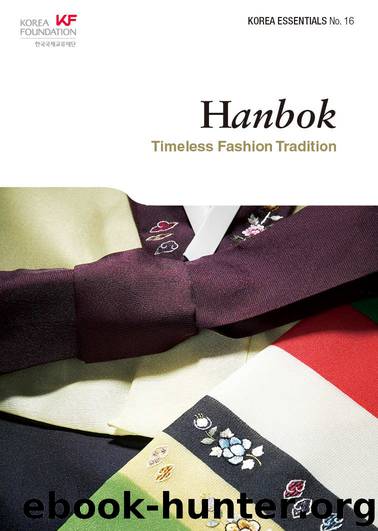Hanbok: Timeless Fashion Tradition (Korea Essentials Book 16) by Samuel Songhoon Lee

Author:Samuel Songhoon Lee
Language: eng
Format: azw3
Publisher: Seoul Selection
Published: 2015-12-15T16:00:00+00:00
Hwarot
Embroidered silk shoes and hwagwan (jeweled jokduri)
HANBOK FOR COMMONERS
The typical hanbok for commoners consisted of a chima, short jeogori, beoseon for women, and baji, waist-length jeogori, durumagi (outer coat), gat (horse hair-hat) and beoseon for men. Dresses were made of cotton, a plant whose cultivation was officially encouraged, the less expensive silk for winter, and hemp or ramie for summer. The winter clothes were lined and padded with a thin layer of cotton batting for the jeogori, baji, and durumagi for further warmth.
Sometimes the jeogori was quilted. Because the colors yellow, red, blue, green, and black were reserved for the ruling elite, commoners had to choose from neutral and earthy colors. Although the durumagi was basically the same style, the ones for the people were simpler in overall design and had narrower sleeves than the ceremonial robes worn by aristocrats. The durumagi began to be worn by all people regardless of class, age, or gender in 1884, when King Gojong decreed a regulation that prohibited expensive and extravagant costumes. The durumagi is still worn in various colors and materials as a part of proper hanbok attire for men and women.
Download
This site does not store any files on its server. We only index and link to content provided by other sites. Please contact the content providers to delete copyright contents if any and email us, we'll remove relevant links or contents immediately.
| Advertising | Annuals |
| Book Design | Branding & Logo Design |
| Fashion Design | Illustration |
| Science Illustration |
Wonder by R.J. Palacio(8430)
Mastering Adobe Animate 2023 - Third Edition by Joseph Labrecque(3720)
Unlabel: Selling You Without Selling Out by Marc Ecko(3574)
Ogilvy on Advertising by David Ogilvy(3485)
Hidden Persuasion: 33 psychological influence techniques in advertising by Marc Andrews & Matthijs van Leeuwen & Rick van Baaren(3454)
Drawing Cutting Edge Anatomy by Christopher Hart(3440)
The Pixar Touch by David A. Price(3347)
POP by Steven Heller(3298)
The Code Book by Simon Singh(3057)
The Art of War Visualized by Jessica Hagy(2932)
Slugfest by Reed Tucker(2924)
The Curated Closet by Anuschka Rees(2897)
Rapid Viz: A New Method for the Rapid Visualization of Ideas by Kurt Hanks & Larry Belliston(2815)
Stacked Decks by The Rotenberg Collection(2796)
365 Days of Wonder by R.J. Palacio(2737)
The Wardrobe Wakeup by Lois Joy Johnson(2717)
Keep Going by Austin Kleon(2682)
Tattoo Art by Doralba Picerno(2583)
Tell Me More by Kelly Corrigan(2579)
